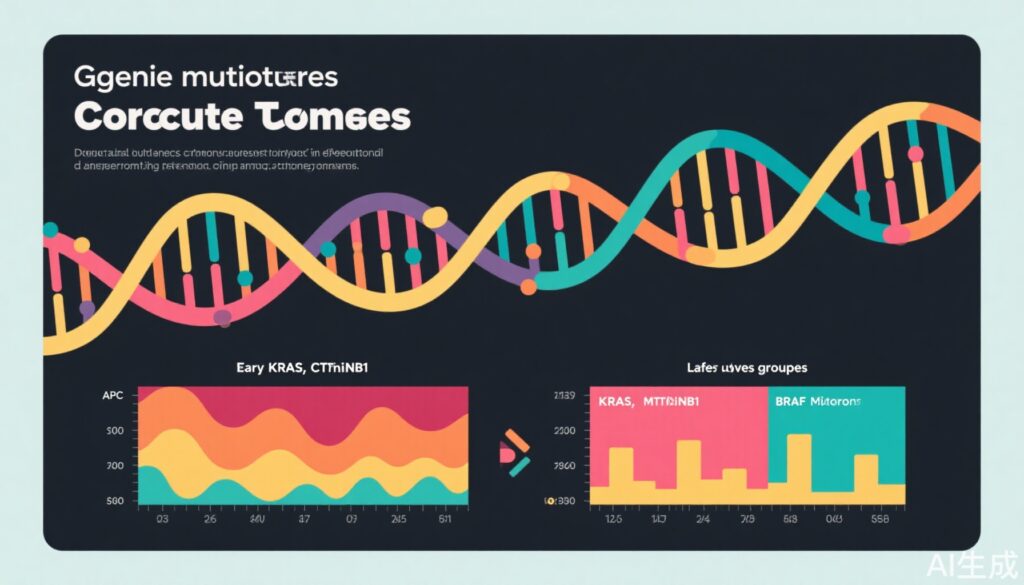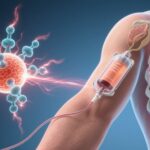Highlights
- Early-onset colorectal cancer (EOCRC) is increasing globally, with distinct somatic mutation patterns compared to late-onset cases (LOCRC).
- EOCRC in the hypermutated group exhibits significantly higher tumor mutational burden (TMB) than LOCRC, with enriched mutations in APC, KRAS, CTNNB1, and TCF7L2 and fewer BRAF mutations.
- Non-hypermutated EOCRC shows a higher frequency of TP53 mutations but a lower overall TMB compared to LOCRC.
- These findings support the need for EOCRC-specific molecular profiling to guide targeted therapy and screening strategies.
Clinical Background and Disease Burden
The incidence of early-onset colorectal cancer (EOCRC), defined as colorectal cancer diagnosed before the age of 50, is rising at an alarming rate worldwide, in stark contrast to the gradual decline observed in late-onset colorectal cancer (LOCRC). EOCRC often presents at more advanced stages and with distinct clinical and pathological features, imposing a growing burden on healthcare systems and challenging traditional prevention and management paradigms. Despite these trends, the molecular underpinnings differentiating EOCRC from LOCRC have remained incompletely understood. Detailed characterization of the genomic mutational landscape in EOCRC is crucial to inform precise, age-adapted interventions, optimize screening protocols, and improve patient outcomes.
Research Methodology
This international, multicohort observational study analyzed genomic data from 17,133 colorectal tumor samples collected across eight countries (Canada, China, France, Nigeria, South Korea, Spain, the Netherlands, and the USA) between January and December 2024. Seven major cohorts contributed to the dataset, including the Memorial Sloan Kettering Cancer Center (USA), Leiden University Medical Center (Netherlands), Nigerian African Research Group for Oncology, GENIE Project (multi-national), Sun Yat-sen University Cancer Center (China), Asan Medical Center (South Korea), and Fudan University Shanghai Cancer Center (China).
Eligible participants were adults (≥18 years) with confirmed colorectal adenocarcinoma or mucinous adenocarcinoma. Tumor specimens underwent whole-exome or targeted clinical-grade sequencing. Samples were stratified into hypermutated (TMB >15 mutations/megabase) and non-hypermutated (TMB ≤15 mutations/megabase) groups. Statistical analyses included gamma regression for TMB comparisons and multivariable logistic regression for mutation frequency differences, with pathway enrichment to explore biological relevance. The primary objective was to compare somatic mutation patterns between EOCRC and LOCRC, stratified by TMB status.
Key Findings
Demographics: Of 17,133 patients, 29.1% had EOCRC. The cohort was diverse: 59.4% White, 22.8% Asian or Pacific Islander, and 5.7% Black.
Tumor Mutational Burden: – In hypermutated tumors, EOCRC had a significantly higher TMB than LOCRC (mean ratio 1.11 [95% CI 1.06-1.16]; p<0.0001). – In non-hypermutated tumors, EOCRC had a lower TMB than LOCRC (mean ratio 2.92 [95% CI 2.88-2.96]; p<0.0001).
Genomic Mutation Patterns:
- In hypermutated EOCRC, 23 genes showed higher mutation frequencies compared to LOCRC. Notably:
- APC: 75.0% (EOCRC) vs 58.6% (LOCRC); OR 2.00 [95% CI 1.59-2.51]; p<0.0001
- KRAS: 53.3% vs 32.0%; OR 2.35 [1.91-2.89]; p<0.0001
- CTNNB1: 31.6% vs 18.0%; OR 2.15 [1.70-2.72]; p<0.0001
- TCF7L2: 51.2% vs 35.0%; OR 2.01 [1.62-2.50]; p<0.0001
- Conversely, BRAF and RNF43 mutations were less frequent in hypermutated EOCRC:
- BRAF: 15.6% vs 44.2%; OR 0.27 [0.21-0.35]; p<0.0001
- RNF43: 39.3% vs 53.9%; OR 0.61 [0.49-0.76]; p=0.0015
- In non-hypermutated tumors, only TP53 mutations were more frequent in EOCRC (79.5% vs 73.7%; OR 1.37 [1.25-1.50]; p<0.0001), while nine genes, including BRAF and KRAS, had lower mutation rates.
Statistical Significance: All major findings were robust to multivariable adjustment and multiple testing corrections.
Mechanistic Insights and Biological Plausibility
The enrichment of somatic mutations in WNT pathway genes (APC, CTNNB1, TCF7L2) and oncogenic drivers such as KRAS in hypermutated EOCRC suggests a distinct carcinogenic process compared to LOCRC. The diminished frequency of BRAF mutations, a hallmark of certain sporadic microsatellite instability-high (MSI-H) colorectal cancers, further supports a unique molecular phenotype in younger patients. The elevated TMB in hypermutated EOCRC may also reflect different environmental exposures, inherited susceptibilities, or DNA repair defects, potentially influencing immunogenicity and responsiveness to immune checkpoint inhibitors.
Expert Commentary
Current expert opinion, including recent reviews (Monge et al., Cancers 2025), underscores the heterogeneity of EOCRC and advocates for precision oncology approaches. The present study’s scale and international diversity strengthen its conclusions and reinforce calls for tailored molecular profiling in EOCRC. These findings may inform future biomarker-driven clinical trials focused on younger CRC patients.
Controversies or Limitations
Despite its strengths, this study is limited by its observational design and potential cohort-specific biases (e.g., differences in sequencing platforms, diagnostic criteria, or regional risk factors). While the analysis adjusted for several confounders, residual confounding cannot be excluded. Additionally, the functional impact of many of the observed mutations in EOCRC, and their direct contribution to tumorigenesis or therapeutic resistance, remains to be clarified.
Conclusion
This landmark international study elucidates the distinct genomic architecture of early-onset colorectal cancer, particularly among hypermutated tumors. The unique mutational signatures identified in EOCRC, including high frequencies of WNT pathway and KRAS mutations and lower BRAF mutation rates, highlight the necessity for age-specific molecular diagnostics and targeted management strategies. As EOCRC continues to rise globally, integrating these molecular insights into clinical guidelines and screening policies will be critical to improving patient outcomes and curbing the growing public health burden.
References
Li J, Pan Y, Guo F, Wang C, Liang L, Li P, Liang W, Lian P, Chen Y, Yang Y, Lin W, Li X, Perea J, Hendrickx WRL, Holowatyj AN, Guo X, Du L, Sinicrope FA, Ma Y. Patterns in genomic mutations among patients with early-onset colorectal cancer: an international, multicohort, observational study. Lancet Oncol. 2025 Aug;26(8):1055-1066. doi: 10.1016/S1470-2045(25)00239-6.
Monge C, Waldrup B, Carranza FG, Velazquez-Villarreal E. Molecular Heterogeneity in Early-Onset Colorectal Cancer: Pathway-Specific Insights in High-Risk Populations. Cancers (Basel). 2025 Apr 15;17(8):1325. doi: 10.3390/cancers17081325. PMID: 40282501; PMCID: PMC12026214.



